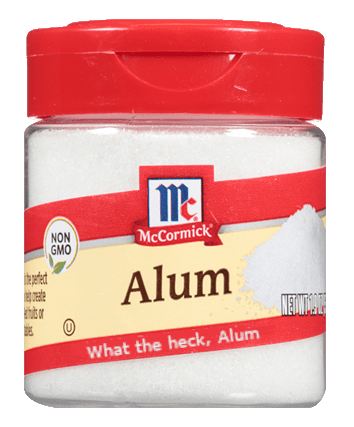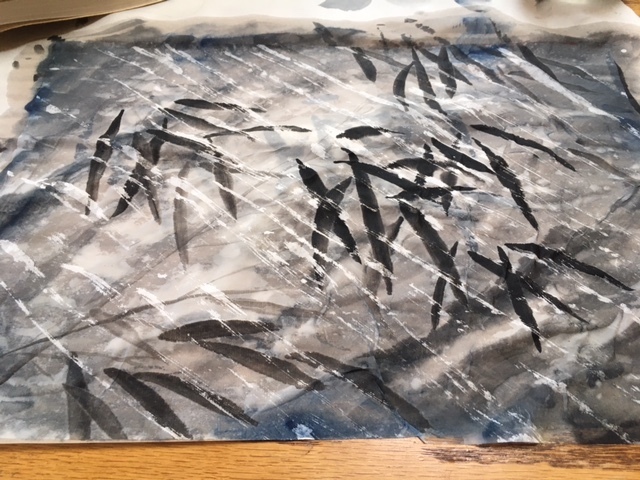Indigo Resist 3: raindrops
Aug. 17th, 2021 07:14 pmBrush painting classes have resumed! The first new class was on the same topic as the last old class: indigo resists. This time we painted the alum in thin lines, so that when we added indigo, there were pale streaky lines in the blue, to represent raindrops.
I don't understand the chemistry of this process. Usually you use alum to make things that don't want to stick to paper or cloth stick better. When alum is dissolved in water, the aluminum atoms get bored of being alum and go stick themselves to the paper or cloth fibers instead. Then some other chemical, like a dye, or gelatin or peach tree sap for glazing paper, can grab onto the aluminums like they're handles.
But in this case, the alum makes the indigo not stick to the paper. What gives?![[personal profile]](https://www.dreamwidth.org/img/silk/identity/user.png) yam made this very scientific illustration of alum in response to my puzzlings:
yam made this very scientific illustration of alum in response to my puzzlings:

Anyway, leaving aside that alum is a sneaky mischief chemical that makes no sense, we started by making a supersaturated solution of alum and water and painting it onto the paper in streaky invisible diagonal lines. We held the brush way down at the tip, so we could squeeze out as much liquid as we wanted. I didn't do very well at that, my lines were uneven and blotchy, though I thought that was probably okay for rain shapes.

Then we painted bamboo.
Then I discovered the alum didn't work with the student-grade paper I was using. So I painted another set of bamboo on better paper.
Bamboo typically represents scholarly virtue. "Upright" meaning "virtuous" as a metaphor apparently exists in Chinese as well as English. It it humble enough to bend when the wind blows, and strong enough not to break in a storm. The hollow centre of the bamboo is a metaphor for a clear mind or an open heart.
Bamboo paintings can be classified as either "sunny" - leaves point up, the vibe is cheerful and new and springlike, or "rainy" - the leaves point down, they're a little more ragged, the vibe is enduring and wintry. We of course made "rainy" style bamboo for our rain paintings.
The leaves are typically painted in groups of 3, 4, or 5. If you need more bamboo leaves, you combine some of the existing patterns. Here is a set of leaf patterns the instructor made for us to copy. She didn't tell us their names, but I've attempted to match her leaf patterns with the ones in the Mustard Seed Garden Manual of Painting:

I think this is the least artificial bamboo I've painted, actually. My "goose in flight" 3-leaf sets are very awkward and stiff and look like sporks or something, but I think overall it's pretty good.

Then painted a mix of indigo and regular soot ink onto it.

As usual, the indigo disappointed me a bit by lightening as it dried, but I'm still pretty happy with how this one came out. The absolute rainiest of rainy bamboos!

I made another one at home, but it doesn't look right. The instructor says it just needs some more bamboo leaves.

My personal favourite thing about bamboos is that they take a very, very long time to flower. There's a species that flowers once every 130 years, and they all flower at once and die. Someday I want to write a story about a vampire hunter who is also a gardener, who notices that his neighbours have arranged their garden to highlight the bamboo flowers, which are still 90 years off or something, and realizes his neighbours have a very different relationship to the passage of time than he does.
I don't understand the chemistry of this process. Usually you use alum to make things that don't want to stick to paper or cloth stick better. When alum is dissolved in water, the aluminum atoms get bored of being alum and go stick themselves to the paper or cloth fibers instead. Then some other chemical, like a dye, or gelatin or peach tree sap for glazing paper, can grab onto the aluminums like they're handles.
But in this case, the alum makes the indigo not stick to the paper. What gives?

Anyway, leaving aside that alum is a sneaky mischief chemical that makes no sense, we started by making a supersaturated solution of alum and water and painting it onto the paper in streaky invisible diagonal lines. We held the brush way down at the tip, so we could squeeze out as much liquid as we wanted. I didn't do very well at that, my lines were uneven and blotchy, though I thought that was probably okay for rain shapes.

Then we painted bamboo.
Then I discovered the alum didn't work with the student-grade paper I was using. So I painted another set of bamboo on better paper.
Bamboo typically represents scholarly virtue. "Upright" meaning "virtuous" as a metaphor apparently exists in Chinese as well as English. It it humble enough to bend when the wind blows, and strong enough not to break in a storm. The hollow centre of the bamboo is a metaphor for a clear mind or an open heart.
Bamboo paintings can be classified as either "sunny" - leaves point up, the vibe is cheerful and new and springlike, or "rainy" - the leaves point down, they're a little more ragged, the vibe is enduring and wintry. We of course made "rainy" style bamboo for our rain paintings.
The leaves are typically painted in groups of 3, 4, or 5. If you need more bamboo leaves, you combine some of the existing patterns. Here is a set of leaf patterns the instructor made for us to copy. She didn't tell us their names, but I've attempted to match her leaf patterns with the ones in the Mustard Seed Garden Manual of Painting:

- a boat
- a fish's tail
- a goose in flight
- this one does not seem to be in my book, it's not landing sparrow, landing goose, startled rook, two fish tails, two swallow tails, or a swallow tail and a fish tail (startled rook is the best bamboo leaf clump name, I want to paint vast mobs of startled rooks henceforth)
- goose in flight + fish tail
- goose in flight + goose in flight
- goose in flight + the one that is not in my book
I think this is the least artificial bamboo I've painted, actually. My "goose in flight" 3-leaf sets are very awkward and stiff and look like sporks or something, but I think overall it's pretty good.

Then painted a mix of indigo and regular soot ink onto it.

As usual, the indigo disappointed me a bit by lightening as it dried, but I'm still pretty happy with how this one came out. The absolute rainiest of rainy bamboos!

I made another one at home, but it doesn't look right. The instructor says it just needs some more bamboo leaves.

My personal favourite thing about bamboos is that they take a very, very long time to flower. There's a species that flowers once every 130 years, and they all flower at once and die. Someday I want to write a story about a vampire hunter who is also a gardener, who notices that his neighbours have arranged their garden to highlight the bamboo flowers, which are still 90 years off or something, and realizes his neighbours have a very different relationship to the passage of time than he does.
no subject
Date: 2021-08-19 12:57 am (UTC)The names for bamboo leaf clusters are very fun :)
no subject
Date: 2021-08-27 05:00 pm (UTC)